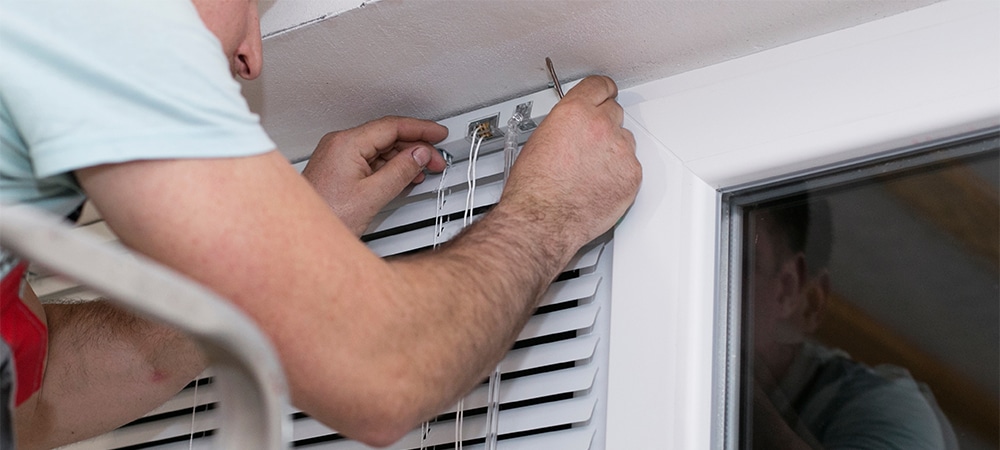How to Fix Window Blinds Cords
We’ve all been there – you’re trying to adjust the light in your room, only to find your window blind cords tangled, frayed, or completely unresponsive. It’s a frustrating experience that can disrupt your day and leave you feeling helpless.
However, properly functioning blind cords are more than just a matter of convenience; they’re also crucial for safety. Broken or tangled cords can pose a strangulation hazard, especially for young children and pets.
The good news is that fixing most blind cord issues doesn’t require a call to a professional. You can often repair your blinds quickly with simple tools and clear instructions. So, roll up your sleeves, and let’s get started!
Related Article: DIY vs. Professional: What You Need to Know About Blind Installation
Identify the Problem
Before getting into repairs, let’s first pinpoint your problem with your window blind cords. Here are a few common issues you might encounter:
- Frayed or Broken Cords: Constant use and exposure to sunlight can weaken the cords, causing them to fray or even snap completely. This can make it difficult or impossible to raise or lower your blinds.
- Tangled Cords: If you have multiple blinds or shades in close proximity, their cords can become tangled, making them difficult to operate. This is especially common in homes with children or pets who might playfully interact with the cords.
- Cords That Won’t Retract or Release Properly: Sometimes, the internal mechanisms within the blind headrail can malfunction, causing the cords to become stuck or unresponsive. This can prevent you from adjusting the blinds to your desired position.
Understanding the specific issue you’re facing will help you choose the right repair approach and gather the necessary tools and materials. Now that we’ve identified the common culprits let’s move on to the next step: gathering your repair kit.
Gather Your Tools and Materials
Now that you’ve diagnosed the problem with your blind cords let’s gather the tools and materials you’ll need to tackle the repair. Most fixes require only a few basic items you probably already have around the house:
- Screwdriver: You’ll need a screwdriver to open the blind headrail and access the internal mechanisms. The type of screwdriver will depend on the specific blinds you have, so take a quick look at the headrail screws before you start.
- Scissors: A pair of scissors will be handy for cutting cords to the correct length and trimming frayed ends.
- Replacement Cord: You’ll need a replacement if your cord is broken or severely frayed. Choose a cord with the same thickness and material as the original.
- Lighter or Cord-Melting Tool: If you’re replacing a cord, you’ll need a lighter or a specialized cord-melting tool to seal the ends and prevent fraying.
- Needle-nose Pliers: These can help grip and manipulate small parts within the blind headrail, but they’re not always necessary.
With these tools, you can move on to the repair process.
Step-by-Step Repair Instructions
Let’s roll up our sleeves and get those blind cords working smoothly again. Here’s a breakdown of how to fix the most common issues:
1. Replacing a Frayed or Broken Cord
This is the most common problem and, thankfully, one of the easiest to fix.
- Safety first: Unplug motorized blinds or disconnect them from the power source before starting any repairs.
- Access the headrail: Use your screwdriver to carefully open the headrail, exposing the blind’s inner workings.
- Remove the old cord: Identify the broken or frayed cord and gently untie or cut it from its attachments.
- Measure and cut the new cord: Measure the length of the old cord and cut the new cord to the same size, leaving a little extra for tying knots.
- Thread the new cord: Follow the path of the old cord, threading the new one through the pulleys and any other mechanisms within the headrail.
- Secure the cord: Tie knots at both ends of the new cord to secure it in place. Use a lighter or cord-melting tool to carefully melt the ends of the cord to prevent fraying.
- Reassemble the headrail: Carefully put the headrail back together and test the blinds to ensure they operate smoothly.
Important: If you need clarification on the exact cord path or mechanism, consider taking a photo before removing the old cord as a reference.
Related Article: Step-by-Step Guide to Measuring Windows Blinds for Installation
2. Untangling Cords
Tangled cords can be trickier, but you can usually get them sorted out with patience and a gentle touch.
- Safety first: Again, disconnect any motorized blinds from their power source.
- Lower the blinds completely: This gives you more cord to work with and makes it easier to see the tangle.
- Gently work out the knots: Use your fingers or a pair of needle-nose pliers to untangle the cords carefully. Be patient and avoid pulling or yanking, as this could damage the cords or the blind mechanism.
- If necessary, cut and retie: If the tangle is too severe, you may need to cut one or more cords and retie them. Remember to melt the ends to prevent fraying.
- Test the blinds: Once the cords are untangled, raise and lower them a few times to ensure they operate smoothly.
Tip: If you have multiple blinds with cords close together, consider using cord cleats or wraps to keep them organized and prevent future tangles.
3. Fixing a Cord That Won’t Retract or Release
This issue usually indicates a problem with the internal cord lock mechanism.
- Safety first: Disconnect any motorized blinds.
- Open the headrail: Access the internal mechanism using your screwdriver.
- Inspect the cord lock: Look for any obstructions or debris preventing the cord from moving freely.
- Gently manipulate the mechanism: If the cord lock is stuck, try gently pushing or pulling on it to release it. You may need to use needle-nose pliers for better grip.
- If necessary, replace the mechanism: If the cord lock is damaged or beyond repair, you may need to replace it. Consult the manufacturer’s instructions or seek professional assistance for this step.
- Reassemble and test: Once the issue is resolved, reassemble the headrail and test the blinds to ensure they operate correctly.
Important: If you’re uncomfortable working with your blinds’ internal mechanisms, don’t hesitate to contact a professional for assistance.
Remember, safety is paramount when working with blind cords. To prevent accidents, always disconnect motorized blinds from power and keep cords out of the reach of children and pets.
Prevention and Maintenance Tips
Prevention can go a long way in keeping your blind cords in good working order and avoiding those frustrating malfunctions. Here are some tips to help you maintain your blinds and prevent future cord problems:
- Handle with care: Avoid excessive pulling or jerking on the cords, as this can put unnecessary strain on them and lead to fraying or breakage.
- Child and pet safety: Keep blind cords out of reach of children and pets. Consider installing cord cleats or wraps to keep cords neatly bundled away from curious hands and paws.
- Regular inspections: Make it a habit to inspect your blind cords periodically for any signs of wear and tear, such as fraying, discolouration, or stiffness. Addressing minor issues early can prevent them from becoming major problems later on.
- Cordless or motorized options: If you’re concerned about cord safety or want a more convenient solution, consider upgrading to cordless or motorized blinds. These options eliminate the need for cords, offering a safer and more streamlined window treatment experience.
Following these simple tips and performing regular maintenance, you can keep your blinds functioning smoothly for years.
Related Article: Window Blinds Installers in the GTA
Pull the Cord on Blind Frustrations
As you’ve seen, fixing most blind cord issues is a manageable DIY project that doesn’t require specialized skills or expensive tools. With patience and the right approach, you can restore your window coverings to their former glory and enjoy the benefits of smoothly operating blinds.
However, if you encounter a particularly complex issue or simply prefer to leave the repairs to the professionals, don’t hesitate to reach out to the experts at Blinds Toronto. We’re here to help with all your window treatment needs, from repairs and maintenance to new installations and upgrades.
So, next time you’re faced with a tangled cord or a broken mechanism, don’t let frustration get the best of you. Take a deep breath, grab your tools, and confidently tackle the repair. You’ll be amazed at how easy it can be to fix those pesky blind cords and restore harmony to your home.

Just another writer from downtown Toronto. I have worked as a window salesman and a blinds installer so I have a great amount of knowledge in this industry.
Favourite Downtown Restaurant: Lee’s
Blinds of choice: Zebra Blinds
Feel free to share my blogs if you find them useful.


